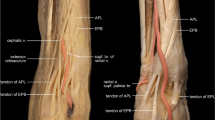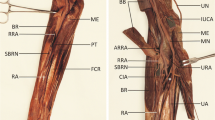Abstract
The superior radial collateral artery (SRCA) was described in well-established anatomy textbooks published in the 1800s. According to those textbooks, the SRCA originates from the brachial artery, passes transversely between the coracobrachialis and the humerus, and distributes to the most distal portion of the deltoid. The SRCA is not listed in the international standard on anatomical terminology, Terminologia Anatomica, or in modern anatomy textbooks. In the present study, we reevaluated the anatomical features of the SRCA by cadaveric dissection. We found that two kinds of SRCAs were consistently present in the upper arm. One was similar to the previous descriptions of the SRCA in terms of origin and course, but the distribution was somewhat different. The other was similar to the previous descriptions in terms of the distribution, although it differed in origin and course. The discrepancy between the description of the SRCA in classical textbooks and the actual morphologies of the SRCA presumably prompted previous anatomists to question the existence of the SRCA, resulting in its absence from anatomical textbooks after a particular time point.


Similar content being viewed by others
References
Adachi B (1928) Das Arteriensystem der Japaner. Band I. Kaiserlich-Japanischen Universität zu Kyoto, Kyoto
Fuss FK, Matula CW, Tschabitscher M (1985) Die Arteria brachialis superficialis. Anat Anz 160:285–294
Gegenbaur C (1892) Lehrbuch der Anatomie des Menschen, 2nd edn. Verlag von Wilhelm Engelmann, Leipzig
Gir P, Cheng A, Oni G, Mojallal A, Saint-Cyr M (2012) Pedicled-perforator (propeller) flaps in lower extremity defects: a systematic review. J Reconstr Microsurg 28:595–601
Henle J (1868) Handbuch der systematischen Anatomie des Menschen, 3rd edn. Drück und Verlag von Friedrich Vieweg und Sohn, Braunschweig
Hennerbichler A, Etzer C, Gruber S, Brenner E, Papp C, Gaber O (2003) Lateral arm flap: analysis of its anatomy and modification using a vascularized fragment of the distal humerus. Clin Anat 16:204–214
Hoffmann CEE (1878) Lehrbuch der Anatomie des Menschen, 2nd edn. Verlag von Eduard Besold, Erlangen
Kawashima T, Yoshitomi S, Sasaki H (2004) Anatomical relationship between the superficial brachial arteries and the brachial plexus in humans, and their morphological significance. Folia Morphol 63:465–471
Saint-Cyr M, Wong C, Buchel EW, Colohan S, Pederson WC (2012) Free tissue transfers and replantation. Plast Reconstr Surg 130:858e–878e
Sakai T (2007) Historical evolution of anatomical terminology from ancient to modern. Anat Sci Int 82:65–81
Serletti JM, Moran SL (2000) Microvascular reconstruction of the breast. Semin Surg Oncol 19:264–271
Steel BJ, Cope MR (2015) A brief history of vascularized free flaps in the oral and maxillofacial region. J Oral Maxillofac Surg 73:786.e1–11
Tang M, Mao Y, Almutairi K, Morris SF (2009) Three-dimensional analysis of perforators of the posterior leg. Plast Reconstr Surg 123:1729–1738
Yoshinaga K, Tanii I, Kodama K (2003) Superficial brachial artery crossing over the ulnar and median nerves from posterior to anterior: embryological significance. Anat Sci Int 78:177–180
Acknowledgments
The authors thank Mrs. Yoko Ito, Dr. Tomomi Nakamura, Mr. Taro Okamura, and Mr. Koichi Ikarashi for their technical assistance.
Author information
Authors and Affiliations
Corresponding author
Ethics declarations
Conflict of interest
The authors have no conflict of interest to declare.
Electronic supplementary material
Below is the link to the electronic supplementary material.
12565_2016_368_MOESM1_ESM.tif
Supplementary Fig. S1 Superficial brachial arteries found in the present study. a Typical brachial artery. b Superior type of superficial brachial artery. c Inferior type of superficial brachial artery. B usual brachial artery, Br brachialis, Cb coracobrachialis, D deltoid, LD latissimus dorsi, M median nerve, Mc musculocutaneous nerve, SB superficial brachial artery, U ulnar nerve (TIFF 2455 kb)
12565_2016_368_MOESM2_ESM.tif
Supplementary Fig. S2 Origin and course of the type-1b SRCA-2. a Whole arterial tree in the left arm with a type-1b SRCA-2 (blue arrowheads) (case 6). b Photograph showing the same arm as in a. b′ Drawing explaining photograph b. The SRCA-2 penetrates the brachialis to distribute to the deltoid. ACH anterior circumflex humeral artery, Ax axillary artery, B brachial artery, Br brachialis, Cb coracobrachialis, CS circumflex scapular artery, D deltoid, IUC inferior ulnar collateral artery, L long head of biceps brachii, LD latissimus dorsi, LM lateral mammary artery, LT lateral thoracic artery, MC median collateral artery, PB profunda brachii artery, PCH posterior circumflex humeral artery, R radial artery, RC radial collateral artery, RN radial nerve, S short head of biceps brachii, SUC superior ulnar collateral artery, Ta thoracoacromial artery, Td thoracodorsal artery, U ulnar artery, asterisks cut edge of the pectoralis major, green arrows SRCA-1 (TIFF 4904 kb)
12565_2016_368_MOESM3_ESM.tif
Supplementary Fig. S3 Origin and course of the type-2 SRCA-2. a The whole arterial tree in the right arm with a type-2 SRCA-2 (blue arrowheads) (case 7). b Photograph showing the same arm as in a. b′ Drawing explaining photograph b. The SRCA-2 originates above the level of the coracobrachialis insertion and passes between the coracobrachialis and the humerus to distribute to the deltoid. ACH anterior circumflex humeral artery, Ax axillary artery, B brachial artery, Br brachialis, Cb coracobrachialis, CS circumflex scapular artery, D deltoid, IUC inferior ulnar collateral artery, L long head of biceps brachii, LD latissimus dorsi, LM lateral mammary artery, LT lateral thoracic artery, MC median collateral artery, PB profunda brachii artery, PCH posterior circumflex humeral artery, R radial artery, RC radial collateral artery, RN radial nerve, S short head of biceps brachii, SUC superior ulnar collateral artery, Ta thoracoacromial artery, Td thoracodorsal artery, U ulnar artery, asterisks cut edge of the pectoralis major, green arrows SRCA-1 (TIFF 4827 kb)
Rights and permissions
About this article
Cite this article
Ichimura, K., Kinose, S., Kawasaki, Y. et al. Reevaluation of the superior radial collateral artery in the human upper arm. Anat Sci Int 93, 69–74 (2018). https://doi.org/10.1007/s12565-016-0368-4
Received:
Accepted:
Published:
Issue Date:
DOI: https://doi.org/10.1007/s12565-016-0368-4




